The following pages are some glimpses of my and my family’s time in Stokes Bay, which began in the mid-1930s and continued to the early 1990s. That was mostly my parent’s time. I was a part of it from my birth in the late 1930s to around 1960, when I graduated from university and started my own separate life, first in Michigan; then from 1963-1993 in California; and from 1993-now, on Hawaii Island. From 1960 on through the 1980s I was only an occasional visitor to Stokes Bay, though I still loved the place and the people. Since moving to Hawaii, I have regretfully only managed to visit 4 times: 1996 (briefly), 2003, 2011 & 2018. Now, at 85 (late 2023), I’d like to get back at least once more.
Who knows if it is in the cards?
The attached photos are part of my collection of hundreds of Stokes Bay & related photos available to VIEW on this site or to view & download at: FLICKR.COM
1930s




In the mid-1930s my parents, Ron & Vera Bertrand, and others in my mother’s family began coming to the Bruce Peninsula, where they settled on Stokes Bay as a gathering spot.
My dad (1904-1999) grew up just south of Windsor and as a young adult in the 1920s moved to Detroit for economic opportunity. His only relative who also came to know Stokes Bay was Villiers McQueen, a younger cousin who was close enough to have been in early photos and who lived in Stokes Bay for some years in the 1960s & 70s (at least some of it in a cabin just before Harter’s, now Heron Pt.).
My mother (1908-1992) grew up in Port Stanley on Lake Erie. Her parents were Ed & Katherine (Dertinger) Hawes. After high school, my mother emigrated to Detroit for work, along with her sister, Pearl. I would expect that my mother met my father in Detroit, but do not know that for sure.
Of her 4 siblings, two spent a lot of time in Stokes Bay. Her brother, Karl and his wife Alice (Jones), as well as sister Eartley, were part of the 1930s arrivals. I know my parents had also spent some summer time in the Muskoka region prior to settling on the Bruce.
So from my birth in 1938 in Detroit, to my leaving the area in the early 1960s for the west coast, Stokes Bay was an important part of my life. It left an indelible image in my brain; an image I sought to recreate, first in the forest-surrounded reaches of far northern California, then with a farm/orchard in the lush Coffee Belt on the Kona Coast of Hawaii (where there is a similar generosity of spirit).



Early 1940s




In my memory, my Uncle Karl & Aunt Alice’s log cabin (above) was always there. And it was, for me. But they apparently bought it around 1939. Located just across the old caisson bridge (now, the old concrete bridge), near the McArthur homestead. The cabin had an entry screened porch, followed by a living room with a bedroom to the left and kitchen/dining room to the right-back, which led to the back shed. Upstairs there were 2 bedrooms (I think). At the back of the attached shed was a hand pump for a perhaps 50’ well (my memory is that around the end of WWII they had the well drilled by the Wright Bros.). There was an outhouse about 30’ from the back door (we were all so naive about the effects on the river when you only have a thin layer of soil over bed rock).
During the war, my mother and I and brother, Bill, spent a good part of the summers there. I do remember coming some of the time by train, which I think terminated south of Wiarton, perhaps at Park Head.
There were few fences (that I can remember) around town. And the people who had cows tended to let them roam. Jack & Annie McLay, I believe, did have a fence, which kept their one cow at home. (I remember Annie churning butter in their back shed and drinking milk directly from the source.) But McArthur’s had several cows equipped with bells which would announce their presence most mornings (“Must be time to get up!”) as they mowed our grass and left their “presents”. No need for lawnmowers, then. But boots were helpful.
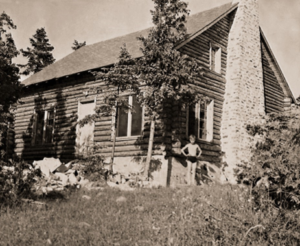
By the time the war was over, my parents decided that they would like to build their own cabin. And Uncle Karl and Aunt Alice let them split off a small chunk of their parcel. So, over the next several years the great log cabin project went on. I am not sure if any real permit was needed. But I do know that the work was headed up by Kenny Smith, who had built the Travis cabins at the government dock and the Vaughan cabins behind Jack & Annie McLay’s, among others. Kenny was a wonderful human being and it seems like for years after, he would stop by regularly for some conversation and maybe a coffee or beer. Actually, almost everyone was like that, with unannounced visits being the norm. Of course, the telephone system was one big party line (well, maybe more than one line), with I think a ring code so you would know if it was for you or not. It didn’t matter. Everyone knew everyone else’s business in short order. But by and large that was with the caring spirit of a shared and interdependent existence.
Late 1940s


The cabin took several years to become fully livable, with my mother and I coming up from Detroit (actually Taylor, a suburban rural township which has since grown into a small city) for the summer. At 8 or 9, I don’t remember doing much myself. But my mother worked along, oiling the logs, applying tung-oil on the floors and more. We had a stonemason (a Liverance from Pike Bay?) in to build the fireplace, likely the summer of 1946. The cabin had 2 bedrooms downstairs (the 2nd small one, mine, became a bathroom & furnace room in the late 60s), along with a living room and small kitchen. Upstairs were 2 bedrooms in one half, with the rest being storage and my dad’s play area for ham radio and later painting.
We bought a simple wooden rowboat and my dad added a 1-1/4 hp Elgin (Sears) outboard motor, which got a lot of use for the next 5 years, putt-putting out to the bay on fishing expeditions and swimming at the “sand bar” just outside the river mouth. That motor was good for many years, even surviving being dropped overboard.
We ate a lot of caught fish (perch, sunfish, small mouth bass & northern pike). And occasionally we would be given, or would buy, a whitefish from Kenny McLay, next door, when they came in with a good catch. My mother would pan-fry them all except maybe baking the bigger whitefish. They were all so scrumptious. We did not know how lucky we were.
As pre-teens in a friendly village, my friends, Ken & Ray McLay, and I had a lot of freedom. We all had chores. They more than me. But there was no worry about where we were or what we were doing when we were on our own. It was all good. It was as safe an environment to grow up in as one could conceive. We had lots of adventures. And even got into a little bit of trouble.
Our families were readily accepted into the community. When we first built our cabin, Ken and Ray would harangue me with “Dirty yankee tourist”. But we got over that quickly (we were, like, 6 or 7 yrs old). But I always did live a kind of contradictory existence. In Stokes I was the city boy (Detroit). But when our rural township shipped us off to a Detroit high school, we were considered the country hicks. Just can’t win!





Early 1950s


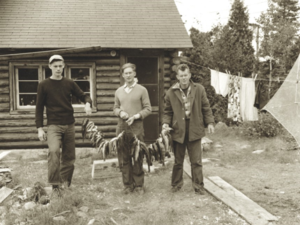
For me and my friends, as we became teens, things changed. My best friends, Ken and Ray McLay found themselves taking on adult duties, helping in their dad’s commercial fishing. They had net mending duties early on. But soon they were going out on the lake, setting nets and reeling in tons of nets with hundreds of pounds of fish. So it seemed we only occasionally had days together, plus the Wednesday & Saturday dance nights at Jeanne’s, attended by young & old.
One such day, when we were around 15, we were walking out to Gauley’s Bay. Most of the way there, we saw some smoke coming from near Jim Sprankel’s place and we were pretty sure he wasn’t there. So, we hiked in. And we found that there was indeed a fire, in the sawdust that insulated the ice in his little icehouse (likely spontaneous combustion). It wasn’t anything big, though there was some danger of it spreading. Anyway, we put it out. We were, I think, later thanked by Walter Charman, another nearby wealthy neighbor and friend to Jim.
Through the 50s our “clan’s” imprint was growing. Bill Kennedy and his mother, friends from Taylor, began coming up some, and soon had purchased a lot just down the road; my dad’s cousin, Villiers was renting a place near Harter’s;
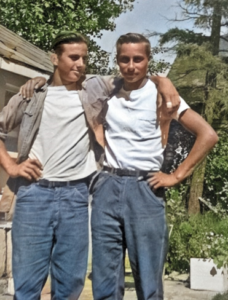
cousin Elizabeth (McCarthy) Edelbrock & her husband, Jack, bought a lot just beyond Kenny McLay’s. Bill K had been friends with my brother Bill in Taylor, as they both had an affinity for model airplanes and motorbikes. But by the 50s my 7 yr older brother was working, married and no longer coming to Stokes much. Thus, Bill K, only 5 years older than me and spending a lot of time there, became a friend to me, taking me fishing and hanging out some.
My 1st long-term paid work experience came when George & Alice Vaughan hired me to be a jack-of-all-trades at the Camp in 1951. I was 13. My job was to clean cabins, pump gas, watch the small store, slug ice out of the icehouse (for cabin-dwellers & to sell), help guests and anything else one can think of. My pay was 25 cents per hour. I’m not sure whether I had any days off, but I must have. In any case, my goal was to have enough money at the end of the summer to buy Bill Kennedy’s 7.5 hp Evinrude outboard, as he was moving up to a 25 hp unit. I saved every cent. And had just enough. In my naiveté, I just assumed that I would stick it on the rowboat and carry on. So, over the winter, my dad had to find a good used boat that was up to the task. And so, we ended up with the 13’ Lyman lapstrake.
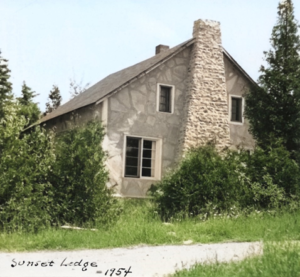
My dad was also a private pilot and owned a small plane, a pre-WWII 40hp Taylorcraft. Some years he would fly up from Detroit, usually landing in Wiarton or a grass field going into Lions Head (my brother, Bill, did those same flights later on in his Cessna). But sometimes he landed on the sand behind the Camp before it was dredged out to make a marina. He had no problems.
And that was where there were occasional community softball games some summers. When I was maybe 12, I got to play by running bases for Harry Hawke, who played & hit, but didn’t run. I was thrilled to be playing with the elders!
Late 1950s +




In the late 50s I was at university and spending less time at Stokes Bay. Life went on their without me. My dad, perhaps anticipating retirement, bought an 18’ Lone Star aluminum boat and sold the Lyman. And went fishing a lot. And played tennis some.
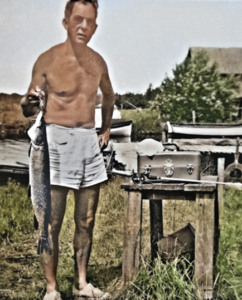
He did not retire until the late 60s, after which he and my mother spent the summers together in Stokes Bay, while spending the winters in a mobile home in Florida, getting in a lot of tennis as my dad played in senior tournaments for some years. They kept this routine up until 1993 when my dad had a severe stroke, with my mother dying a year later. The cabin was sold in 1996. My dad died in 1999.
The Edelbrocks lasted until the early 2000s, with Jack dying in 2009 in Michigan and Liz is presently in hospice care. Aunt Earley’s son, John Hetherington, still uses their cottage. Bill Kennedy still seems to be going strong and he still has the home he built in Stokes, which he and his 2 sons still visit.


